Executed Renaissance
You can help expand this article with text translated from the corresponding article in Ukrainian. (April 2017) Click [show] for important translation instructions.
|

(1893–1933)
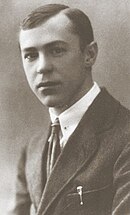
(1901–1937)
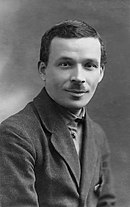
(1892–1937)

(1892–1937)

(1887–1937)

(1890–1937)

(1891–1937)

(1868–1941)

(1895–1937)

(1895–1937)

(1899–1984)

(1882–1937)

(1898–1936)
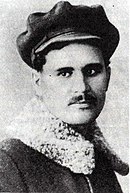
(1901–1937)

(1871–1938)

(1899–1937)

(1895–1937)

(1890–1929)

(1899–1934)

(1901–1938)

(1900–1938)

(1889–1939)
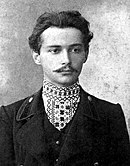
(1885–1941)

(1898–1938)

(1888–1934)

(1891–1937)

(1891–1934)

(1882–1938)

(1891–1937)
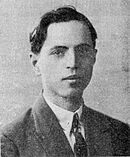
(1903–1937)

(1898–1937)
The Executed Renaissance (or "Red Renaissance", Ukrainian: Розстріляне відродження, Червоний ренесанс, romanized: Rozstriliane vidrodzhennia, Chervonyi renesans)[1] was a generation of Ukrainian language poets, writers, and artists of the 1920s and early 1930s who lived in the Ukrainian Soviet Socialist Republic and wеre killed by the Soviet regime.
Following the 1917 Bolshevik Revolution, Lenin's nationality policies of Korenizatsiya (lit. "Indigenization") favored the revival of minority and heritage languages, encouraging them to be taught in the schools and published and providing them with material support and visibility. The poets and writers of the Ukrainianization generation were often resident in the Slovo Building in Kharkiv, which was then the capital of Soviet Ukraine. With the 1929's Great Turn or "Great Break", newly appointed Soviet Premier and CPSU Secretary General Joseph Stalin reversed those policies in favor of State centralisation, Socialist Realism, and Russification. While outwardly pro-Soviet, Ukrainian language school teachers, poets, and writers refused to submit to Stalin's restoration of Tsarist policies of linguistic imperialism. In retaliation, Ukrainian language schoolteachers, as well as poets, writers and dramatists who wrote in the same language were arrested en masse, deported to the Gulag, imprisoned or executed. Those victims were also part of Stalin's larger 1937-1938 Great Purge, with its most infamous killing field being at Sandarmokh forest, a mass grave site in Karelia where an estimated 6000 political prisoners from the Solovki concentration camp were secretly executed and buried by the NKVD.
"The Executed Renaissance", as a term, was first suggested in 1959 in Paris[2] by anti-communist Polish émigré publisher Jerzy Giedroyc of the influential Kultura magazine. He was writing to Ukrainian émigré and literary critic Yuriy Lavrinenko to recommend the title for the 1959 anthology of the best Ukrainian literature by the Ukrainianization generation.[3]
In a 2023 article for The Guardian, Joseph Stalin's destruction of the Executed Renaissance was compared to a second alleged decimation of Ukrainian intellectuals by the Russian military during Vladimir Putin's invasion of Ukraine, with alleged killings on the battlefronts, trenches as well as in strikes on civilian areas.[2]
Background
[edit]The collapse of the Russian Empire during the First World War, the abolition of imperial censorship, the establishment of an independent Ukrainian State, and the cultural leniency of the Soviet regime in the 1920s together led to an astonishing renaissance of literary and cultural activities in Ukraine.[4] Scores of new writers and poets appeared and formed dozens of literary groups that changed the face of Ukrainian literature.[5] These processes were supported by the policies of nativization (in Ukraine it was called Ukrainization), the New Economic Policy of State Capitalism (1921–1927), and the drive to eliminate illiteracy.
As a title
[edit]The term the "Executed Renaissance" was first proposed in 1959 by Jerzy Giedroyc, editor of Kultura publishers in Paris, which was devoted to publishing anti-communist writers from throughout the Polish diaspora.[6] In a 13 August 1958 letter to Yuriy Lavrinenko, Giedroyc referred to an anthology of recent Ukrainian literature which Lavrinenko had prepared at Giedroyc's request:
"About the name. Could it be better to give it a generic name: Executed Renaissance. Anthology 1917–1933 etc. The name would then sound spectacular. On the other hand, the humble name Anthology can only facilitate penetration by the Iron Curtain. What do you think?"
"So be it," replied Lavrinenko.
The book The Executed Renaissance, An Anthology, 1917–1933: Poetry, prose, drama and the essay, published in Paris by Kultura (1959), remains one of the most important sources for the history of Ukrainian literature during the period.[7] It includes the best examples of Ukrainian poetry, prose and essay-writing from the 1920s and early 1930s.
According to Ukrainian literary historian Yarina Tsymbal, The Executed Renaissance was "a good name for the anthology, but unsuitable for the whole generation of creative intelligentsia." In her view, the "Red Renaissance" is a more apt metaphor because it was a self-description. The latter term first appeared in 1925 when Olexander Leites' book The Renaissance of Ukrainian Literature and the poem "The Call of the Red Renaissance" by Volodymyr Gadzinskyi[8] were published simultaneously and independently. That same year, the magazine Neo-Lif appeared with a preface by Gadzinskyi:[9] "For us the past is only a means of cognizing the present and future," he wrote, "a useful experience and an important practice in the great structure of the Red Renaissance."
A new elite
[edit]Lavrinenko, however, saw "the Executed Renaissance" as more than just the title of an anthology. He promoted it as a term encapsulating the martyrdom of Ukrainian poets and their legacy and power to resurrect Ukrainian culture.[6] The Executed Renaissance paradigm, together with the national-communist perspective and as a framework for the nationalization of Ukraine's early Soviet intellectuals, would later emerge as part of an effort to establish a national opposition to the Communist regime with the new intellectual elite eventually contributing to a struggle for an independent and united country.[10]
The main elements in the outlook of the new Ukrainian intellectuals were rebellion, independent thought, and genuine belief in their own ideals. The intellectuals emphasised the individual rather than the masses. Like many other proponents of inner emigration in a police state, their outward "Sovietness" concealed deep searches and queries.
Arising from the lower classes (servants, families of priests, industrial workers and peasants), the new generation of the Ukrainian elite often lacked the opportunity for systematic education because of war, famine and the need to earn their daily bread. Working "on the brink of the possible", using every opportunity to get in contact with world culture and to spread the wings of their creativity, the new generation of the Ukrainian artistic elite were imbued with the latest trends and created truly topical art.
At this time a new generation arose, bearing the moral burden of victories and defeats in the struggle for national independence, with an understanding of Ukraine's path in world history, independent in its judgements, with diverse ideas about the development of Ukrainian literature, when, according to Solomiia Pavlychko,[11] literature
"got a much wider audience than ever before. The level of education of this audience has increased. For the first time, a large number of writers and intellectuals worked in literature. For the first time Ukrainian scientists spoke to the audience of national universities. For the first time different artistic directions, groups, and schools were rapidly differentiated. However, the tendency for the modernization of cultural life coexisted from the outset with a parallel tendency for its subordination to ideology and then to complete destruction."
Literary groups
[edit]For the most part writers were consolidated into literary organizations with different styles or positions. The period between 1925 and 1928 saw a "literary discussion" initiated by Mykola Khvylovy. One of its objects was to determine the ways in which the new Ukrainian Soviet literature would develop and define the role of the writer in society. Khvylovy and his associates supported an orientation towards West European rather than Russian culture; they rejected "red graphomania" but did not reject Communism as a political ideology.
The main literary organizations of that time were:
- Hart (Ukrainian: Гарт, hardening) existed from 1923 to 1925. Its main goal was uniting of all kinds of proletarian artists with further development of proletarian culture. One of the requirements of "Hart" was using of Ukrainian language. The organization ceased to exist after the death of its leader Vasyl Ellan-Blakytny.[12]
- VAPLITE (Ukrainian: ВАПЛІТЕ, "The Free Academy of Proletarian Literature") was created in 1926 by Mykola Khvylovy on the base of "Hart". Its goal was to create a new Ukrainian literature by adopting the best achievements of Western European culture. VAPLITE accepted Communism as political ideology but rejected the necessity for ideological meaning in literature as its main requirement Among the members of VAPLITE were Oleksandr Dovzhenko, Mykola Kulish, Les Kurbas, Mayk Johansen, Pavlo Tychyna, Oleksa Slisarenko, Mykola Bazhan, Yuriy Smolych and Yulian Shpol.[13]
- MARS (Ukrainian: МАРС, "The Workshop of Revolutionary Literature") existed from 1924 to 1929 (primarily under name of "Lanka"). The main postulate of MARS was to honestly and artistically describe that epoch. Among its members were Valerian Pidmohylny, Hryhorii Kosynka, Yevhen Pluzhnyk, Borys Antonenko-Davydovych, Todos Osmachka, Ivan Bahrianyi and Maria Halych.
- Aspanfut (Ukrainian: Аспанфут), later Komunkult (Ukrainian: Комункульт) was an organization of Ukrainian futurists. Their values were "Communism, Internationalism, Industrialism, Rationalization, Inventions and Quality".[14] Among its members were Mykhayl Semenko, Heo Shkurupiy, Yuriy Yanovsky and Yulian Shpol.
- The Neo-Classicists (Ukrainian: Неокласики) were a literary movement of modernists among whose followers were Mykola Zerov, Maksym Rylsky, Pavlo Fylypovych and Mykhailo Drai-Khmara. They never established a formal organization or programme, but shared cultural and aesthetic interests. The Neo-Classicists were concerned with the production of high art and disdained "mass art", didactic writing, and propagandistic work.[15]
- Pluh (Ukrainian: Плуг, plough), an organization of rural writers. Their main postulate was the "struggle against proprietary ideology among peasants and promotion of the Proletarian Revolution's ideals". Among its members were Serhiy Pylypenko, Petro Panch, Dokiia Humenna and Andrii Holovko.[16]
- Zakhidna Ukraina (Ukrainian: Західна Україна; English: West Ukraine) after April 1926 it separated from Pluh as an independent literary organization of fifty writers and artists from West Ukraine based in Kyiv, Odesa, Dnipro and Poltava. Headed first by Dmytro Zagul, later by Myroslav Irchan.
Innovation
[edit]The writers of the Ukrainian (Red) Renaissance divided prose in two: plot (narrative) prose and non-plot prose. In the non-plot works, it was not the sentence or the word that was paramount, but the subtext, the spirit, or as Khvylovyi put it, the "smell of the word".[17] The style of strong feelings and penetration of phenomena is called "neo-romanticism" or "expressionism". Among the many Ukrainian-language authors working in this style were Mykola Khvylovy ("Julia Shpol"), Yurii Yanovsky, Andrii Holovko, Oleksa Vlyko, Les Kurbas and Mykola Kulish.
The main themes of Khvylovy's novel Ya (Romantyka) (I am (romance))[18] are disappointment in the Revolution, and the screaming contradictions and divided nature of human beings at that time. The main character is without a name, and therefore without personality or soul. For the sake of the Revolution he murders his mother and then reproves himself: "Was the Revolution worth such a sacrifice?"
In Valeryan Pidmogylny's novel The City, for the first time in Ukrainian literature, elements of existentialism emerged. In pursuit of pleasure its protagonist advances from the satisfaction of his physical desires to the highest religious needs. Even with such a complex subject matter, however, the author does not turn his novel into a simple narrative of "people's" philosophy, but grasps it creatively in its application to a national worldview.
In the Ukrainian-language poetry of the time, the most interesting development is the quest pursued by the Symbolists Olexandr Oles and Pavlo Tychyna. In The Clarinets of the Sun, Tychyna reflected the breadth of an educated and subtle mind contemplating the richness of his national heritage and striving to uncover its root causes.
When the Communist Party of the USSR realized it could not control such writers [clarification needed], it began to use impermissible methods of repression: it forced them into silence, subjected them to crushing public criticism, and arrested or executed them. Writers faced a choice between suicide (Khvylovyi in 1933) and the concentration camps (Gulag) (B. Antonenko-Davidovich and Ostap Vyshnya); they could retreat into silence (Ivan Bahrianyi and V. Domontovich), leave Ukraine (V. Vynnychenko and Yevhen Malaniuk), or write works that glorified the Communist Party (P. Tychyna and Mykola Bazhan). Most artists of this brief Renaissance were arrested and imprisoned or shot.
Deportation, arrests, executions (1933–1938)
[edit]In 1927, Stalin abolished the New Economic Policy and turned to the forced industrialisation and the collectivization of agriculture of the First Five-Year Plan.
Changes in cultural politics also occurred. An early example was the 1930 show trial of the "Union for the Freedom of Ukraine" at which 45 intellectuals, higher education professors, writers, a theologian and a priest were publicly prosecuted in Kharkiv, then capital of Soviet Ukraine. Fifteen of the accused were executed, many more with links to the defendants (248) were sent to the camps. (This was one of a series of contemporary show trials, held in the North Caucasus, 1929 in Shakhty, and in Moscow, the 1930 Industrial Party Trial and the 1931 Menshevik Trial.)
The systematic elimination of the Ukrainian intelligentsia dates back to May 1933 when Mykhailo Yalovyi was arrested; in response Mykola Khvylovy committed suicide in the "Slovo" (Word) Building in Kharkiv. The campaign ran from 1934 to 1940, reaching a peak during the Great Terror of 1937–1938. A total of 223 writers were arrested and in a number of cases imprisoned and shot. Almost three hundred representatives of the Ukrainian Renaissance of the 1920s and 1930s were shot between 27 October and 4 November 1937 at Sandarmokh, a massive killing field in Karelia (northwest Russia).[19]
Some important representatives of this generation survived. Many remained in the Soviet Union: Oleksandr Dovzhenko, Pavlo Tychyna, Maksym Rylskyi, Borys Antonenko-Davydovych, Ostap Vyshnia, and Mykola Bazhan. A few emigrated: Ulas Samchuk, George Shevelov, and Ivan Bahrianyi.
The scale of the tragedy
[edit]Exact figures for Ukrainian intellectuals imprisoned and executed during the Great Terror are not available. It is, by comparison, relatively straightfoward to determine how many writers were involved. The "Slovo" Association (Ukrainian writers in emigration) sent its assessment on 20 December 1954 to the Second All-Union Congress of Writers in the USSR: in 1930, works by 259 Ukrainian writers were in print; after 1938 only 36 writers were published (13.9% of the earlier total). According to "Slovo", 192 of the "missing" 223 writers were deported, sent to the Gulag or executed; a further 16 disappeared; and eight writers committed suicide.[20]
These data are confirmed by The Altar of Sorrow (ed., Olexii Musiienko), a martyrology of Ukrainian writers, which numbers 246 writer-victims of Stalin's terror.[21] Other sources indicate that 228 of 260 Ukrainian writers were deported, imprisoned or shot.[22]
Writers, poets, artists, dramatists
[edit]- Borys Antonenko-Davydovych (5 August 1899 – 8 May 1984) – writer, translator and linguist. (Well-known dissident writer.[23])
- Ivan Bahrianyi (2 October 1906 – 25 August 1963, West Germany) – writer, essayist, novelist and politician.
- Vasyl Bobynsky (11 March 1898 – 8 January 1938) – poet, journalist, and translator; shot in Gulag.
- Mykhailo Boychuk (30 October 1882 – 13 July 1937) – painter, most commonly known as a monumentalist; shot in Kyiv.
- Kost Bureviy (2 August 1888 – 15 December 1934) – poet, playwright, theater and literary critic, translator; shot in Kyiv.
- Dmytro Buzko (1891 – 14 November 1937) – poet and writer; shot in Odesa.
- Veronika Cherniakhivska (25 April 1900 – 3 November 1938) – poet and translator; shot in Kyiv.
- Oles Dosvitny (8 November 1891 – 3 March 1934) – poet; shot in Kharkiv.
- Mykhailo Draj-Khmara (10 October 1889 – 19 January 1939) – poet and translator; died in Gulag.
- Hryhorii Epik (17 January 1901 – 3 November 1937) – writer and journalist; shot at Sandarmokh.
- Dmytro Falkivskyj (3 November 1898 – 16 December 1934) – poet, novelist, translator, screenwriter; shot in Kyiv.
- Pavlo Fylypovych (2 October 1891 – 3 November 1937) – poet and translator; shot at Sandarmokh.
- Myroslav Irchan (14 July 1897 – 3 November 1937) – storywriter and playwright; shot at Sandarmokh.
- Pylyp Kaperlgorodsky (26 November 1882 – 19 May 1938) – writer; shot near Poltava.
- Arkady Kazka (23 September 1890 – 23 November 1929) – poet translator; committed suicide.
- Hnat Khotkevych (31 December 1877 – 8 October 1938) – writer, ethnographer, playwright, composer, musicologist and bandura player; executed.
- Mykola Khvylovy (13 December 1893 – 13 May 1933) – prose writer and poet; committed suicide.
- Hryhoriy Kosynka (29 November 1899 – 15 December 1934) – writer and translator.
- Mykola Kulish (19 December 1892 – 3 November 1937) – prose writer and dramatist; shot at Sandarmokh.
- Les Kurbas (25 February 1887 – 3 November 1937) – film and theater director; shot at Sandarmokh.
- Mykhailo Lozynsky (30 July 1880 – 3 November 1937) – literature and theater critic, journalist; shot at Sandarmokh.
- Vasyl Lypkivsky (7 September 1864 – 27 November 1937) – church reformer, preacher, teacher, publicist, writer and translator; shot at Sandarmokh.
- Ivan Mykytenko (6 September 1897 – 4 October 1937) – writer and playwright; shot at Kharkiv.
- Sofiya Nalepinska-Boychuk (30 July 1884 — 11 December 1937) – artist; shot in Kyiv.
- Ivan Padalka (15 November 1894 – 13 July 1937) – painter, art professor and author; shot in Kyiv.
- Valerian Pidmohylny (2 February 1901 – 3 November 1937) – prose writer; shot at Sandarmokh.
- Yevhen Pluzhnyk (26 December 1898—2 February 1936) – poet, playwright and translator; died on Solovki.
- Klym Polishchuk (25 November 1891– November 1937) – journalist, poet and prose writer; shot at Sandarmokh.
- Anton Prykhodko (1891-29 January 1938) – writer, statesman.
- Sergiy Pylypenko (22 July 1891 – 3 December 1934) – writer; executed.
- Geo Shkurupiy (20 April 1903 – 8 December 1937) – writer, screenwriter and journalist; executed in Saint Petersburg.
- Oleksa Slisarenko (28 March 1891 – 3 November 1937) – poet and writer; shot at Sandarmokh.
- Oleksandr Sokolovsky (8 September 1896 – 22 August 1938) – novelist; executed.
- Myroslava Sopilka (1897-1937) - poet, novelist. Shot in Kyiv.
- Liudmyla Starytska-Cherniakhivska[24] (17 August 1868 – 1941) – writer, translator and literary critic; defendant at the Kharkiv show trial of the "Union for the Freedom of Ukraine" (1930).
- Volodymyr Svidzinsky (9 October 1885 – 18 October 1941) – poet and translator.
- Vasily Sedlyar (12 April 1899 – 13 July 1937) – painter, illustrator and art teacher; executed in Kyiv.
- Mykhaylo Semenko (19 December 1892—24 October 1937) – poet, prominent representative of the futuristic Ukrainian poetry of the 1920s; ?shot at Sandarmokh.
- Dmytro Tas (28 January 1901 – 28 February 1938) – writer, neo-symbolist poet, journalist and translator; executed near Moscow.
- Oleksa Vlyzko (17 February 1908 – 8 December 1934) – poet, writer and futurist; executed in Kyiv.
- Marko Voronyi (18 March 1904 – 3 November 1937) – (children) poet and translator; shot at Sandarmokh.
- Mykola Voronyi (6 December 1871 – 7 June 1938) – writer, poet, actor and director; executed in Odesa.
- Vasyl Vrazhlyvy (1903 – 8 December 1937) – writer; shot in Kyiv.
- Yuri Vukhnal (5 October 1906 – 15 July 1937) – writer-humorist and satirist; executed in Saint Petersburg.
- Mykhailo Yalovyi (5 June 1895 – 3 November 1937) – poet, prosaist and dramatist; shot at Sandarmokh.
- Volodymyr Yaroshenko (23 May 1898 – 13 July 1937) – poet, fabulist, writer and screenwriter; shot in Kyiv.
- Maik Yohansen (pseudonyms: Willy Wetzelius and M. Kramar) (16 October 1895 – 27 October 1937) – poet, prose writer, dramatist, translator, critic and linguist; shot at Sandarmokh.
- Mykola Zerov (26 April 1890 – 3 November 1937) – poet, translator, classical and literary scholar and critic; shot at Sandarmokh.
See also
[edit]- Anti-Ukrainian sentiment
- History of Ukrainian literature
- Sandarmokh (killing field and memorial complex, Karelia)
- Slovo Building (Kharkiv)
- Slovo House (2017 film)
- The Executed Renaissance Anthology, Kultura: Paris (1959)
- 1937 mass execution of Belarusians
- Yurii Kerpatenko
References
[edit]- ^ "Життя і смерть Миколи Хвильового. Від комуніста до комунара". Історична правда. Retrieved 2023-02-17.
- ^ a b Higgins, Charlotte (2023-07-14). "Stalin erased one generation of Ukraine's artists. Now Putin is killing another – including my friend". The Guardian. ISSN 0261-3077. Retrieved 2023-07-14.
- ^ Lushnycky, Andrej N.; Riabchuk, Mykola (2009). Ukraine on Its Meandering Path Between East and West. Bern: Peter Lang. p. 185. ISBN 978-3-03911-607-2.
- ^ "Executed Renaissance: The Erasure of Ukrainian Cultural Heritage in the Times of the Soviet Union". Retrospect Journal. 2020-11-22. Retrieved 2022-02-24.
- ^ HRYN, HALYNA (2004). "The Executed Renaissance Paradigm Revisited". Harvard Ukrainian Studies. 27 (1/4): 67–96. ISSN 0363-5570. JSTOR 41036862.
- ^ a b Fedor, Julie (2016). Journal of Soviet and Post-Soviet Politics and Society: 2015/2: Double Special Issue: Back from Afghanistan: The Experiences of Soviet Afghan War Veterans and: Martyrdom & Memory in Post-Socialist Space. Stuttgart, Germany: Columbia University Press. ISBN 978-3-8382-6806-4.
- ^ ""Executed Renaissance": today 70 years of beginning of extermination of Ukrainian elite". FrontNews. Retrieved 2019-09-16.
- ^ "Ярина Цимбал: "Психологічний роман передував масовим жанрам"" [Yaryna Tsymbal: "The psychological novel preceded mass genres"]. ЛітАкцент – світ сучасної літератури (in Ukrainian). 2016-03-03. Archived from the original on March 6, 2016. Retrieved 2019-09-16.
{{cite web}}: CS1 maint: unfit URL (link) - ^ "100 років українському футуризму" [Centennial of Ukrainian Futurism]. www.facebook.com. Retrieved 2019-09-16.
- ^ Palko, Olena (2021). Making Ukraine Soviet: Literature and Cultural Politics under Lenin and Stalin. London: Bloomsbury Publishing. p. 14. ISBN 978-1-7883-1305-6.
- ^ Павличко С. Дискурс модернізму в українській літературі: [монографія] / С. Павличко. — К.: Либідь, 1997. — C. 170.
- ^ Нагорний К.О. Проблема національного самоствердження в публіцистиці лідера літературного угруповання "Гарт" В. Блакитного
- ^ Ю. Луцький. Джерела до історії Вапліте
- ^ A quotation from the Futurists' manifesto in their magazine Nova Generatsiya.
- ^ "Neoclassicists". www.encyclopediaofukraine.com.
- ^ "Плуг" [Plow]. feb-web.ru.
- ^ Khomenko, Halyna (2018). "Mykola Khvylovyi and the French Republic of Literature: the Experience of Re-reading". Studia Polsko-Ukraińskie. 5: 111–122. doi:10.32612/uw.23535644.2018.pp.111-122. ISSN 2353-5644.
- ^ Khvylovy, Mykola. I am (romance).
- ^ Юрій Лавріненко Розстріляне відродження: Антологія 1917–1933. Archived December 13, 2010, at the Wayback Machine — Київ: Смолоскип, 2004.
- ^ Юрій Лавріненко (2004). "Розстріляне відродження: Антологія 1917—1933" [Shot Revival: An Anthology 1917-1933]. Київ: Смолоскип publishers. Archived from the original on 2010-12-13. Retrieved 2014-07-02."Юрій Лавріненко. РОЗСТРІЛЯНЕ ВІДРОДЖЕННЯ". Archived from the original on 2010-12-13. Retrieved 2014-07-02.
- ^ Іменник мартиролога українського письменства // Микола Жулинський. Безодня української печалі… Archived 2010-10-21 at the Wayback Machine
- ^ Червоний ренесанс. Фільм третій: Безодня (1930—1934). — Кіностудія «Контакт». 2004. — 47:01/51:33.
- ^ "The trial of Valentyn Moroz, 17–18 November 1970". A Chronicle of Current Events. 31 December 1970.
- ^ Krys, Svitlana (2016) 'Book Review: Liudmyla Starytska-Cherniakhivska, The Living Grave: A Ukrainian Legend and Klym Polishchuk, Treasure of the Ages: Ukrainian Legends', EWJUS: East/West: Journal of Ukrainian Studies, Vol 3, No 2, pp. 213–215
Bibliography
[edit]- Юрій Лавріненко. Розстріляне відродження: Антологія 1917–1933. — Київ: Смолоскип, 2004.
- Розстріляне Відродження
- Orest Subtelny. Ukraine: A History. University of Toronto Press, 2000 – 736 p.
- Mace James Ernest. Communism and the Dilemmas of National Liberation: National Communism in Soviet Ukraine, 1918—1933 / James Earnest Mace, Harvard Ukrainian Research Institute, Ukrainian Academy of Arts and Sciences in the United States. Cambridge: Distributed by Harvard University Press for the Harvard Ukrainian Research Institute and the Ukrainian Academy of Arts and Sciences in the U.S., 1983. — 334 pp.
- Розстріляне Відродження
- Executed Renaissance
- Anti-Ukrainian sentiment
- Crimes of the communist regime in Ukraine against Ukrainians
- Cultural history of Ukraine
- History of Ukrainian literature
- Interwar period
- Theatre in Ukraine
- Political repression in Ukraine
- Political and cultural purges
- Massacres of Ukrainians
- Stalinism in Ukraine
- Ukrainian poetry
- Ukrainian Soviet Socialist Republic
- Historiography of Ukraine
